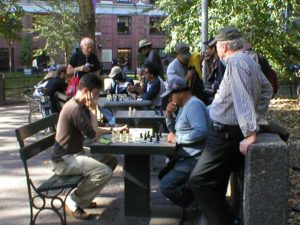Facilitating a meeting? Introducing our free guide
 This blog and the two that follow are to tell you about the resources that Rhizome offers that introduce topics crucial to us and the organisations and groups we work with: meeting facilitation; groups; and diversity.
This blog and the two that follow are to tell you about the resources that Rhizome offers that introduce topics crucial to us and the organisations and groups we work with: meeting facilitation; groups; and diversity.
Facilitation, with which I’m starting, reminds me of playing chess. You start by learning the rules (move your knights before your bishops, occupy the centre, etc. etc.). Then, when you’ve learned the rules, you spend years learning how and when to break them. It feels like a waste, but obviously it’s hard to learn to break a rule if you don’t know that rule in the first place.
 Sometimes, too, you only learn why a rule matters by breaking it. In my training to run Future Search Conferences, which usually have 64 people, meeting for two or three days, we were firmly told to make sure that the topic was of paramount concern to the participants. I found out the hard way why that matters. For an event in Bristol on education, sponsored by the government, I acquiesced in a subject that was of much more interest to the sponsor than to the participants. On the third day, the participants informed me and my co-facilitator, very politely, that they were no longer going to stick to the theme prescribed: they were going to do their own thing for the rest of the day. That was embarrassing.
Sometimes, too, you only learn why a rule matters by breaking it. In my training to run Future Search Conferences, which usually have 64 people, meeting for two or three days, we were firmly told to make sure that the topic was of paramount concern to the participants. I found out the hard way why that matters. For an event in Bristol on education, sponsored by the government, I acquiesced in a subject that was of much more interest to the sponsor than to the participants. On the third day, the participants informed me and my co-facilitator, very politely, that they were no longer going to stick to the theme prescribed: they were going to do their own thing for the rest of the day. That was embarrassing.
So my first piece of advice is to follow the rules until you feel confident to break them – or maybe to start by bending them a little.
My second piece of advice is to remember that some of the most important aspects of facilitation cannot be turned into rules. One of our 2011 blogs cited Viv McWaters saying that this ‘is why I think so much facilitation training is based around methods and techniques, processes. Facilitating by numbers. It’s easy to teach, easy to learn. It’s satisfying. You can recount to others what you have learned. I have books full of these processes, these activities – some of them published, some of them created by me. Yet knowing these is not enough.’
Viv points out that what matters above all is the personal qualities that the facilitator brings to the occasion. Her top two are:
Empathy
This is the ability to put yourself in the shoes of the participants, to realise that they probably have done this sort of thing before, that they have their own ideas and want an opportunity to talk with each other. It’s about ‘knowing’ in a completely different way what the group needs and wants at this time.
Humility
This is recognising the power you have as a facilitator and letting it go, and to be comfortable not being the centre of attention. In fact, it’s about actively ensuring that you are not the centre of attention, and recognising the ideas that emerge from elsewhere.’
In sum, our introductory guide can start you on the journey – but only you and the qualities that you possess and cultivate can get you to your destination.


Diversity, our introductory guide - Rhizome
August 21, 2017 @ 10:40 am
[…] you read our last post, you’ll know that this is the second of a short series of three blogs to introduce and share our […]